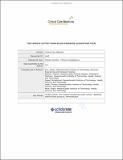The cardiac output from blood pressure algorithms trial
Author(s)
Sun, James X.; Reisner, Andrew T.; Saeed, Mohammed; Heldt, Thomas; Mark, Roger Greenwood
DownloadJames and Andrew CO-BP submitted (2).pdf (1.233Mb)
PUBLISHER_POLICY
Publisher Policy
Article is made available in accordance with the publisher's policy and may be subject to US copyright law. Please refer to the publisher's site for terms of use.
Terms of use
Metadata
Show full item recordAbstract
Objective: The value of different algorithms that estimate cardiac output (CO) by analysis of a peripheral arterial blood pressure (ABP) waveform has not been definitively identified. In this investigation, we developed a testing data set containing a large number of radial ABP waveform segments and contemporaneous reference CO by thermodilution measurements, collected in an intensive care unit (ICU) patient population during routine clinical operations. We employed this data set to evaluate a set of investigational algorithms, and to establish a public resource for the meaningful comparison of alternative CO-from-ABP algorithms.
Design: A retrospective comparative analysis of eight investigational CO-from-ABP algorithms using the Multiparameter Intelligent Monitoring in Intensive Care II database.
Setting: Mixed medical/surgical ICU of a university hospital.
Patients: A total of 120 cases.
Interventions: None.
Measurements: CO estimated by eight investigational CO-from-ABP algorithms, and COTD as a reference.
Main Results: All investigational methods were significantly better than mean arterial pressure (MAP) at estimating direction changes in COTD. Only the formula proposed by Liljestrand and Zander in 1928 was a significantly better quantitative estimator of COTD compared with MAP (95% limits-of-agreement with COTD: -1.76/+1.41 L/min versus -2.20/+1.82 L/min, respectively; p < 0.001, per the Kolmogorov-Smirnov test). The Liljestrand method was even more accurate when applied to the cleanest ABP waveforms. Other investigational algorithms were not significantly superior to MAP as quantitative estimators of CO.
Conclusions: Based on ABP data recorded during routine intensive care unit (ICU) operations, the Liljestrand and Zander method is a better estimator of COTD than MAP alone. Our attempts to fully replicate commercially-available methods were unsuccessful, and these methods could not be evaluated. However, the data set is publicly and freely available, and developers and vendors of CO-from-ABP algorithms are invited to test their methods using these data.
Date issued
2009-01Department
Harvard University--MIT Division of Health Sciences and Technology; Massachusetts Institute of Technology. Research Laboratory of ElectronicsJournal
Critical Care Medicine
Publisher
Wolters Kluwer
Citation
Sun, James X. et al. "The cardiac output from blood pressure algorithms trial." Critical Care Medicine. 37(1):72-80, January 2009.
Version: Original manuscript
ISSN
0090-3493
